Female Genital Mutilation: A Sociological Analysis of the Practice
VerifiedAdded on 2020/03/13
|6
|1450
|64
Essay
AI Summary
This essay delves into the practice of Female Genital Mutilation (FGM), also known as female genital cutting, a procedure involving the partial or total removal of external female genitalia for non-therapeutic reasons. The essay explores the four types of FGM as classified by the World Health Organization, including clitoridectomy, excision, infibulation, and other harmful procedures. It provides background information, highlighting the prevalence in various countries, particularly in Africa, Asia, and the Middle East. The essay examines the cultural and religious motivations behind FGM, such as aesthetic purposes, prevention of rape, religious beliefs, and the preservation of virginity. It also discusses the health consequences, including bleeding, infections, and complications during pregnancy and childbirth. The essay further touches upon the efforts of international organizations and NGOs in combating FGM, including legal and policy initiatives. It also notes the varying views on FGM, including the debate on whether it is rooted in religion or culture, and the various types of FGM practiced in different regions.
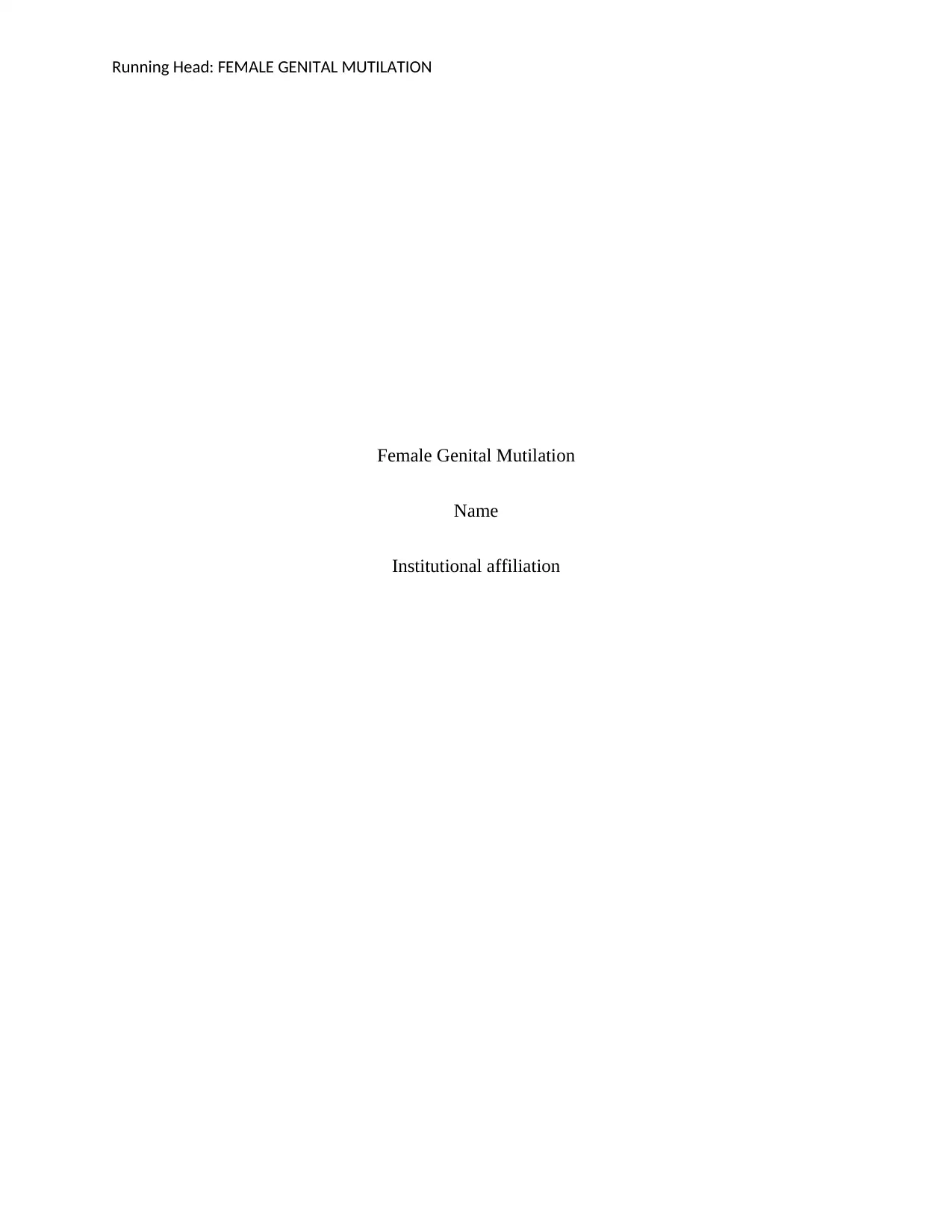
Running Head: FEMALE GENITAL MUTILATION
Female Genital Mutilation
Name
Institutional affiliation
Female Genital Mutilation
Name
Institutional affiliation
Paraphrase This Document
Need a fresh take? Get an instant paraphrase of this document with our AI Paraphraser
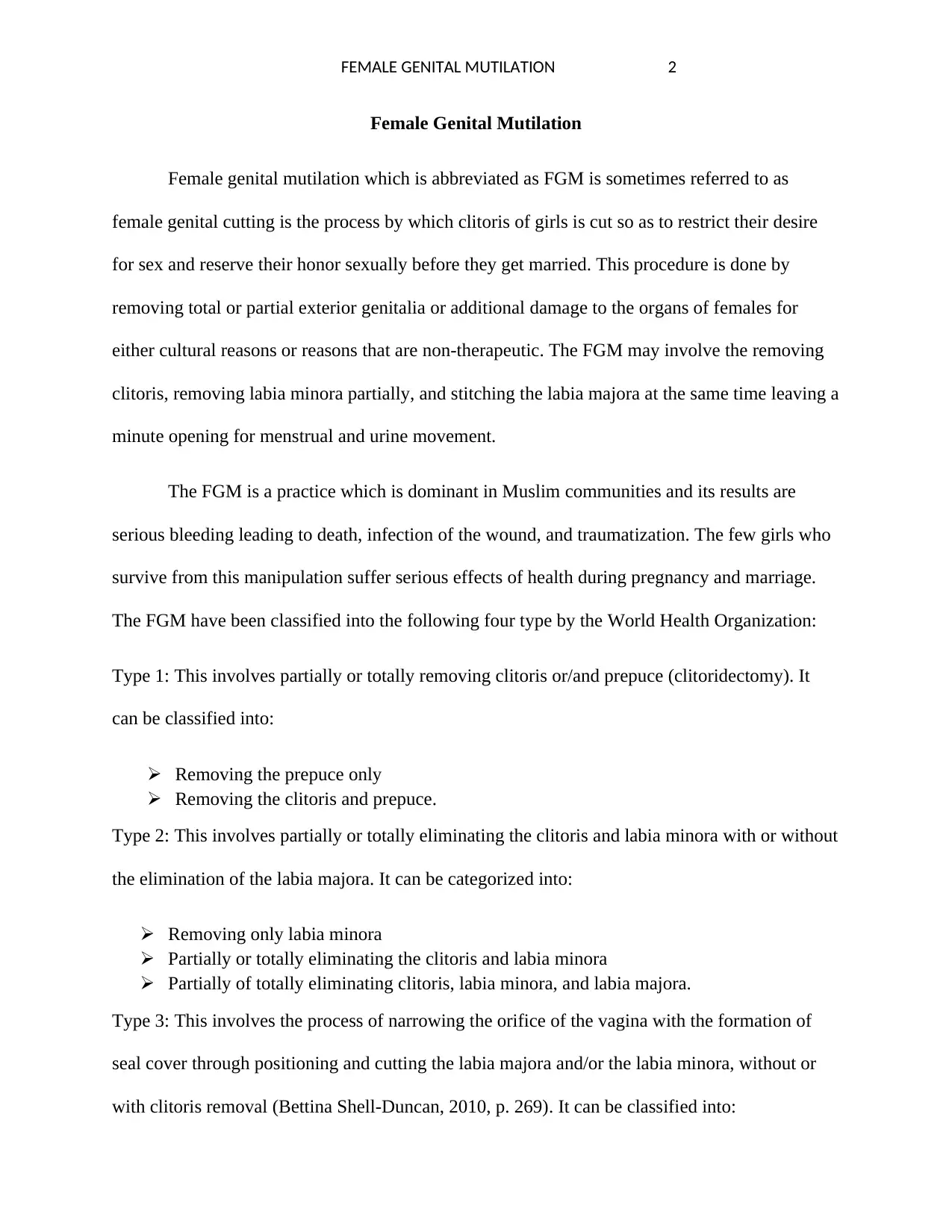
FEMALE GENITAL MUTILATION 2
Female Genital Mutilation
Female genital mutilation which is abbreviated as FGM is sometimes referred to as
female genital cutting is the process by which clitoris of girls is cut so as to restrict their desire
for sex and reserve their honor sexually before they get married. This procedure is done by
removing total or partial exterior genitalia or additional damage to the organs of females for
either cultural reasons or reasons that are non-therapeutic. The FGM may involve the removing
clitoris, removing labia minora partially, and stitching the labia majora at the same time leaving a
minute opening for menstrual and urine movement.
The FGM is a practice which is dominant in Muslim communities and its results are
serious bleeding leading to death, infection of the wound, and traumatization. The few girls who
survive from this manipulation suffer serious effects of health during pregnancy and marriage.
The FGM have been classified into the following four type by the World Health Organization:
Type 1: This involves partially or totally removing clitoris or/and prepuce (clitoridectomy). It
can be classified into:
Removing the prepuce only
Removing the clitoris and prepuce.
Type 2: This involves partially or totally eliminating the clitoris and labia minora with or without
the elimination of the labia majora. It can be categorized into:
Removing only labia minora
Partially or totally eliminating the clitoris and labia minora
Partially of totally eliminating clitoris, labia minora, and labia majora.
Type 3: This involves the process of narrowing the orifice of the vagina with the formation of
seal cover through positioning and cutting the labia majora and/or the labia minora, without or
with clitoris removal (Bettina Shell-Duncan, 2010, p. 269). It can be classified into:
Female Genital Mutilation
Female genital mutilation which is abbreviated as FGM is sometimes referred to as
female genital cutting is the process by which clitoris of girls is cut so as to restrict their desire
for sex and reserve their honor sexually before they get married. This procedure is done by
removing total or partial exterior genitalia or additional damage to the organs of females for
either cultural reasons or reasons that are non-therapeutic. The FGM may involve the removing
clitoris, removing labia minora partially, and stitching the labia majora at the same time leaving a
minute opening for menstrual and urine movement.
The FGM is a practice which is dominant in Muslim communities and its results are
serious bleeding leading to death, infection of the wound, and traumatization. The few girls who
survive from this manipulation suffer serious effects of health during pregnancy and marriage.
The FGM have been classified into the following four type by the World Health Organization:
Type 1: This involves partially or totally removing clitoris or/and prepuce (clitoridectomy). It
can be classified into:
Removing the prepuce only
Removing the clitoris and prepuce.
Type 2: This involves partially or totally eliminating the clitoris and labia minora with or without
the elimination of the labia majora. It can be categorized into:
Removing only labia minora
Partially or totally eliminating the clitoris and labia minora
Partially of totally eliminating clitoris, labia minora, and labia majora.
Type 3: This involves the process of narrowing the orifice of the vagina with the formation of
seal cover through positioning and cutting the labia majora and/or the labia minora, without or
with clitoris removal (Bettina Shell-Duncan, 2010, p. 269). It can be classified into:
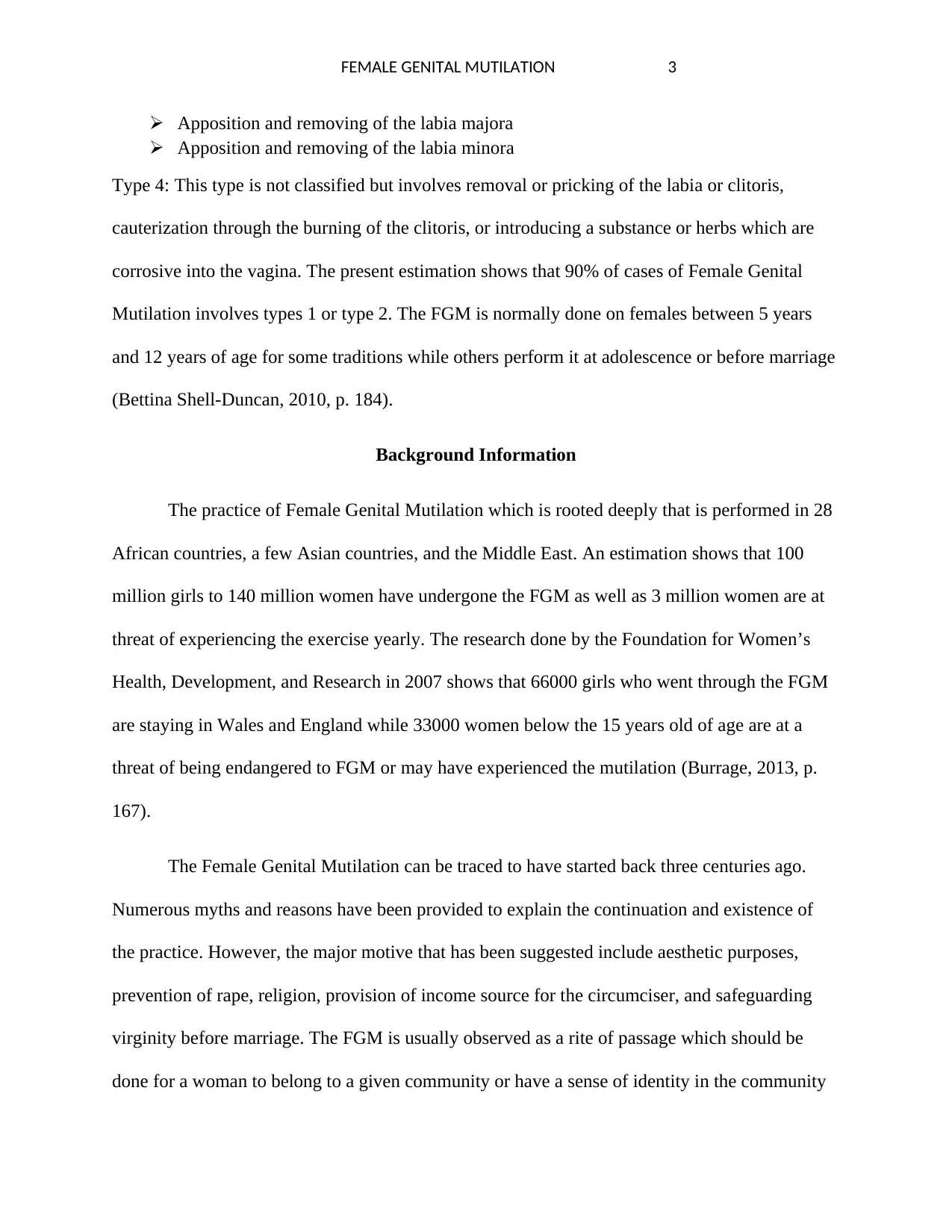
FEMALE GENITAL MUTILATION 3
Apposition and removing of the labia majora
Apposition and removing of the labia minora
Type 4: This type is not classified but involves removal or pricking of the labia or clitoris,
cauterization through the burning of the clitoris, or introducing a substance or herbs which are
corrosive into the vagina. The present estimation shows that 90% of cases of Female Genital
Mutilation involves types 1 or type 2. The FGM is normally done on females between 5 years
and 12 years of age for some traditions while others perform it at adolescence or before marriage
(Bettina Shell-Duncan, 2010, p. 184).
Background Information
The practice of Female Genital Mutilation which is rooted deeply that is performed in 28
African countries, a few Asian countries, and the Middle East. An estimation shows that 100
million girls to 140 million women have undergone the FGM as well as 3 million women are at
threat of experiencing the exercise yearly. The research done by the Foundation for Women’s
Health, Development, and Research in 2007 shows that 66000 girls who went through the FGM
are staying in Wales and England while 33000 women below the 15 years old of age are at a
threat of being endangered to FGM or may have experienced the mutilation (Burrage, 2013, p.
167).
The Female Genital Mutilation can be traced to have started back three centuries ago.
Numerous myths and reasons have been provided to explain the continuation and existence of
the practice. However, the major motive that has been suggested include aesthetic purposes,
prevention of rape, religion, provision of income source for the circumciser, and safeguarding
virginity before marriage. The FGM is usually observed as a rite of passage which should be
done for a woman to belong to a given community or have a sense of identity in the community
Apposition and removing of the labia majora
Apposition and removing of the labia minora
Type 4: This type is not classified but involves removal or pricking of the labia or clitoris,
cauterization through the burning of the clitoris, or introducing a substance or herbs which are
corrosive into the vagina. The present estimation shows that 90% of cases of Female Genital
Mutilation involves types 1 or type 2. The FGM is normally done on females between 5 years
and 12 years of age for some traditions while others perform it at adolescence or before marriage
(Bettina Shell-Duncan, 2010, p. 184).
Background Information
The practice of Female Genital Mutilation which is rooted deeply that is performed in 28
African countries, a few Asian countries, and the Middle East. An estimation shows that 100
million girls to 140 million women have undergone the FGM as well as 3 million women are at
threat of experiencing the exercise yearly. The research done by the Foundation for Women’s
Health, Development, and Research in 2007 shows that 66000 girls who went through the FGM
are staying in Wales and England while 33000 women below the 15 years old of age are at a
threat of being endangered to FGM or may have experienced the mutilation (Burrage, 2013, p.
167).
The Female Genital Mutilation can be traced to have started back three centuries ago.
Numerous myths and reasons have been provided to explain the continuation and existence of
the practice. However, the major motive that has been suggested include aesthetic purposes,
prevention of rape, religion, provision of income source for the circumciser, and safeguarding
virginity before marriage. The FGM is usually observed as a rite of passage which should be
done for a woman to belong to a given community or have a sense of identity in the community
⊘ This is a preview!⊘
Do you want full access?
Subscribe today to unlock all pages.

Trusted by 1+ million students worldwide
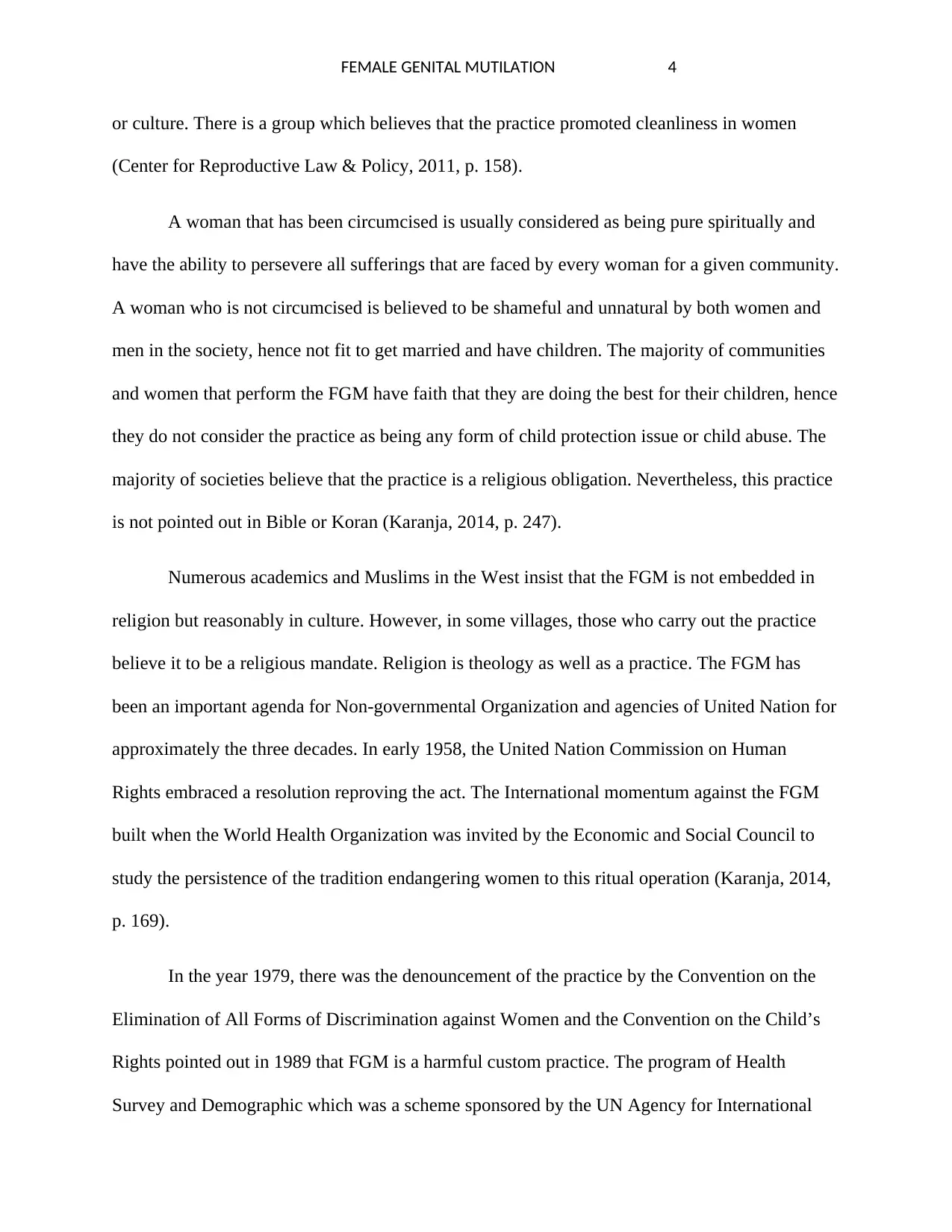
FEMALE GENITAL MUTILATION 4
or culture. There is a group which believes that the practice promoted cleanliness in women
(Center for Reproductive Law & Policy, 2011, p. 158).
A woman that has been circumcised is usually considered as being pure spiritually and
have the ability to persevere all sufferings that are faced by every woman for a given community.
A woman who is not circumcised is believed to be shameful and unnatural by both women and
men in the society, hence not fit to get married and have children. The majority of communities
and women that perform the FGM have faith that they are doing the best for their children, hence
they do not consider the practice as being any form of child protection issue or child abuse. The
majority of societies believe that the practice is a religious obligation. Nevertheless, this practice
is not pointed out in Bible or Koran (Karanja, 2014, p. 247).
Numerous academics and Muslims in the West insist that the FGM is not embedded in
religion but reasonably in culture. However, in some villages, those who carry out the practice
believe it to be a religious mandate. Religion is theology as well as a practice. The FGM has
been an important agenda for Non-governmental Organization and agencies of United Nation for
approximately the three decades. In early 1958, the United Nation Commission on Human
Rights embraced a resolution reproving the act. The International momentum against the FGM
built when the World Health Organization was invited by the Economic and Social Council to
study the persistence of the tradition endangering women to this ritual operation (Karanja, 2014,
p. 169).
In the year 1979, there was the denouncement of the practice by the Convention on the
Elimination of All Forms of Discrimination against Women and the Convention on the Child’s
Rights pointed out in 1989 that FGM is a harmful custom practice. The program of Health
Survey and Demographic which was a scheme sponsored by the UN Agency for International
or culture. There is a group which believes that the practice promoted cleanliness in women
(Center for Reproductive Law & Policy, 2011, p. 158).
A woman that has been circumcised is usually considered as being pure spiritually and
have the ability to persevere all sufferings that are faced by every woman for a given community.
A woman who is not circumcised is believed to be shameful and unnatural by both women and
men in the society, hence not fit to get married and have children. The majority of communities
and women that perform the FGM have faith that they are doing the best for their children, hence
they do not consider the practice as being any form of child protection issue or child abuse. The
majority of societies believe that the practice is a religious obligation. Nevertheless, this practice
is not pointed out in Bible or Koran (Karanja, 2014, p. 247).
Numerous academics and Muslims in the West insist that the FGM is not embedded in
religion but reasonably in culture. However, in some villages, those who carry out the practice
believe it to be a religious mandate. Religion is theology as well as a practice. The FGM has
been an important agenda for Non-governmental Organization and agencies of United Nation for
approximately the three decades. In early 1958, the United Nation Commission on Human
Rights embraced a resolution reproving the act. The International momentum against the FGM
built when the World Health Organization was invited by the Economic and Social Council to
study the persistence of the tradition endangering women to this ritual operation (Karanja, 2014,
p. 169).
In the year 1979, there was the denouncement of the practice by the Convention on the
Elimination of All Forms of Discrimination against Women and the Convention on the Child’s
Rights pointed out in 1989 that FGM is a harmful custom practice. The program of Health
Survey and Demographic which was a scheme sponsored by the UN Agency for International
Paraphrase This Document
Need a fresh take? Get an instant paraphrase of this document with our AI Paraphraser
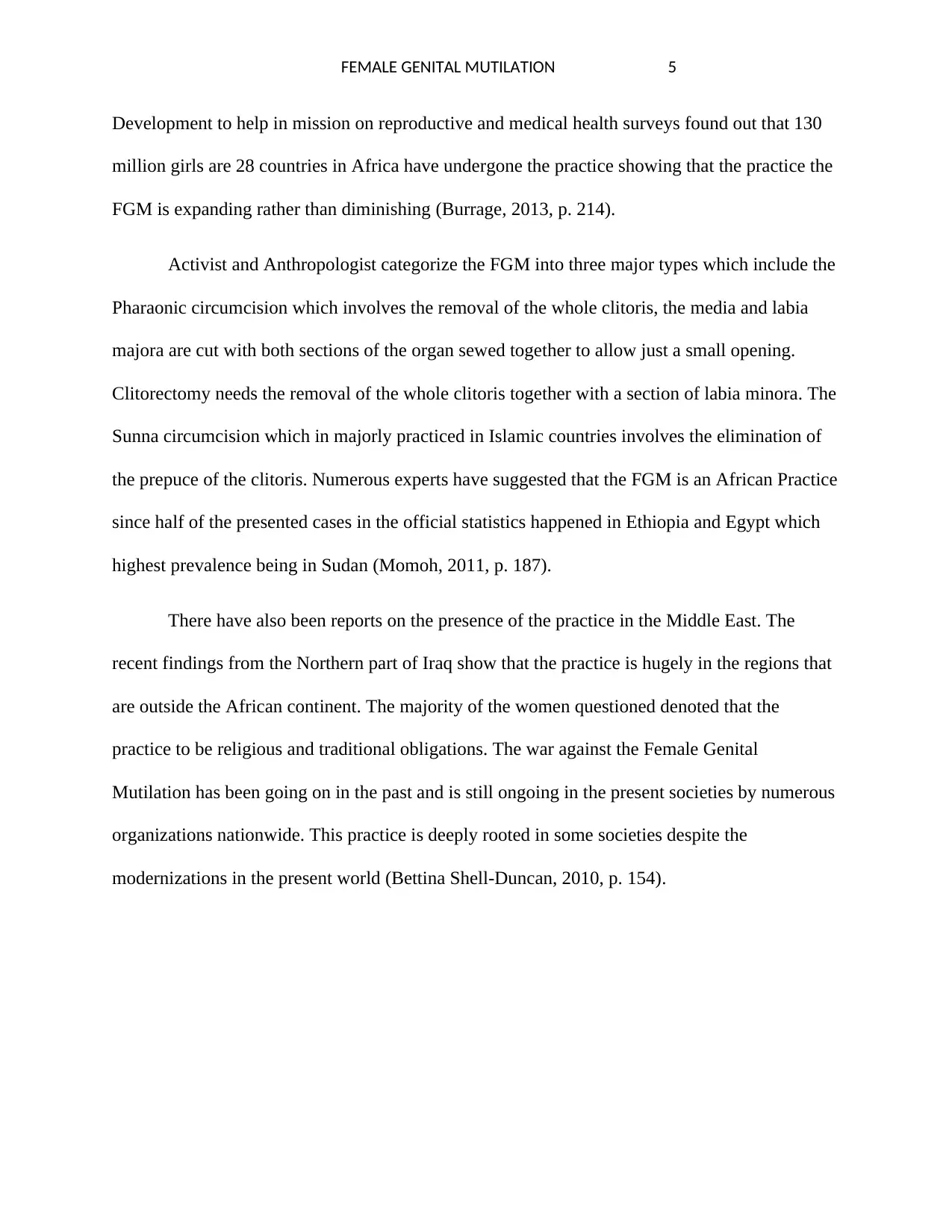
FEMALE GENITAL MUTILATION 5
Development to help in mission on reproductive and medical health surveys found out that 130
million girls are 28 countries in Africa have undergone the practice showing that the practice the
FGM is expanding rather than diminishing (Burrage, 2013, p. 214).
Activist and Anthropologist categorize the FGM into three major types which include the
Pharaonic circumcision which involves the removal of the whole clitoris, the media and labia
majora are cut with both sections of the organ sewed together to allow just a small opening.
Clitorectomy needs the removal of the whole clitoris together with a section of labia minora. The
Sunna circumcision which in majorly practiced in Islamic countries involves the elimination of
the prepuce of the clitoris. Numerous experts have suggested that the FGM is an African Practice
since half of the presented cases in the official statistics happened in Ethiopia and Egypt which
highest prevalence being in Sudan (Momoh, 2011, p. 187).
There have also been reports on the presence of the practice in the Middle East. The
recent findings from the Northern part of Iraq show that the practice is hugely in the regions that
are outside the African continent. The majority of the women questioned denoted that the
practice to be religious and traditional obligations. The war against the Female Genital
Mutilation has been going on in the past and is still ongoing in the present societies by numerous
organizations nationwide. This practice is deeply rooted in some societies despite the
modernizations in the present world (Bettina Shell-Duncan, 2010, p. 154).
Development to help in mission on reproductive and medical health surveys found out that 130
million girls are 28 countries in Africa have undergone the practice showing that the practice the
FGM is expanding rather than diminishing (Burrage, 2013, p. 214).
Activist and Anthropologist categorize the FGM into three major types which include the
Pharaonic circumcision which involves the removal of the whole clitoris, the media and labia
majora are cut with both sections of the organ sewed together to allow just a small opening.
Clitorectomy needs the removal of the whole clitoris together with a section of labia minora. The
Sunna circumcision which in majorly practiced in Islamic countries involves the elimination of
the prepuce of the clitoris. Numerous experts have suggested that the FGM is an African Practice
since half of the presented cases in the official statistics happened in Ethiopia and Egypt which
highest prevalence being in Sudan (Momoh, 2011, p. 187).
There have also been reports on the presence of the practice in the Middle East. The
recent findings from the Northern part of Iraq show that the practice is hugely in the regions that
are outside the African continent. The majority of the women questioned denoted that the
practice to be religious and traditional obligations. The war against the Female Genital
Mutilation has been going on in the past and is still ongoing in the present societies by numerous
organizations nationwide. This practice is deeply rooted in some societies despite the
modernizations in the present world (Bettina Shell-Duncan, 2010, p. 154).
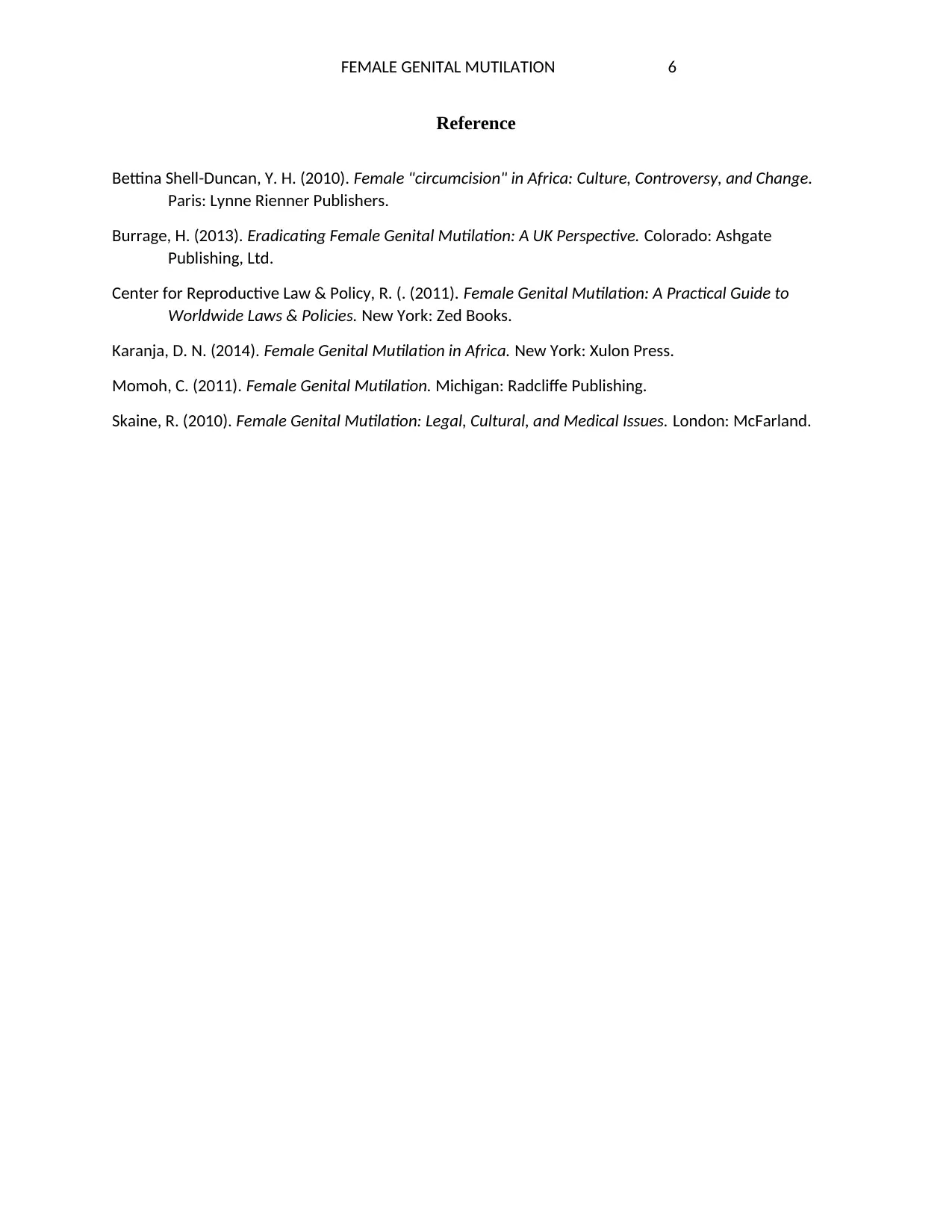
FEMALE GENITAL MUTILATION 6
Reference
Bettina Shell-Duncan, Y. H. (2010). Female "circumcision" in Africa: Culture, Controversy, and Change.
Paris: Lynne Rienner Publishers.
Burrage, H. (2013). Eradicating Female Genital Mutilation: A UK Perspective. Colorado: Ashgate
Publishing, Ltd.
Center for Reproductive Law & Policy, R. (. (2011). Female Genital Mutilation: A Practical Guide to
Worldwide Laws & Policies. New York: Zed Books.
Karanja, D. N. (2014). Female Genital Mutilation in Africa. New York: Xulon Press.
Momoh, C. (2011). Female Genital Mutilation. Michigan: Radcliffe Publishing.
Skaine, R. (2010). Female Genital Mutilation: Legal, Cultural, and Medical Issues. London: McFarland.
Reference
Bettina Shell-Duncan, Y. H. (2010). Female "circumcision" in Africa: Culture, Controversy, and Change.
Paris: Lynne Rienner Publishers.
Burrage, H. (2013). Eradicating Female Genital Mutilation: A UK Perspective. Colorado: Ashgate
Publishing, Ltd.
Center for Reproductive Law & Policy, R. (. (2011). Female Genital Mutilation: A Practical Guide to
Worldwide Laws & Policies. New York: Zed Books.
Karanja, D. N. (2014). Female Genital Mutilation in Africa. New York: Xulon Press.
Momoh, C. (2011). Female Genital Mutilation. Michigan: Radcliffe Publishing.
Skaine, R. (2010). Female Genital Mutilation: Legal, Cultural, and Medical Issues. London: McFarland.
⊘ This is a preview!⊘
Do you want full access?
Subscribe today to unlock all pages.

Trusted by 1+ million students worldwide
1 out of 6
Your All-in-One AI-Powered Toolkit for Academic Success.
+13062052269
info@desklib.com
Available 24*7 on WhatsApp / Email
![[object Object]](/_next/static/media/star-bottom.7253800d.svg)
Unlock your academic potential
Copyright © 2020–2025 A2Z Services. All Rights Reserved. Developed and managed by ZUCOL.

